In nature, the yucca appears as a large shrub, the birthplace of which is South America and Mexico. Lovers often purchase them for the home to decorate the interior. Yucca, home care for which should be carried out according to her requirements, belongs to unpretentious plants.
Material Content:
Species and varieties
In nature, there are more than 50 species.
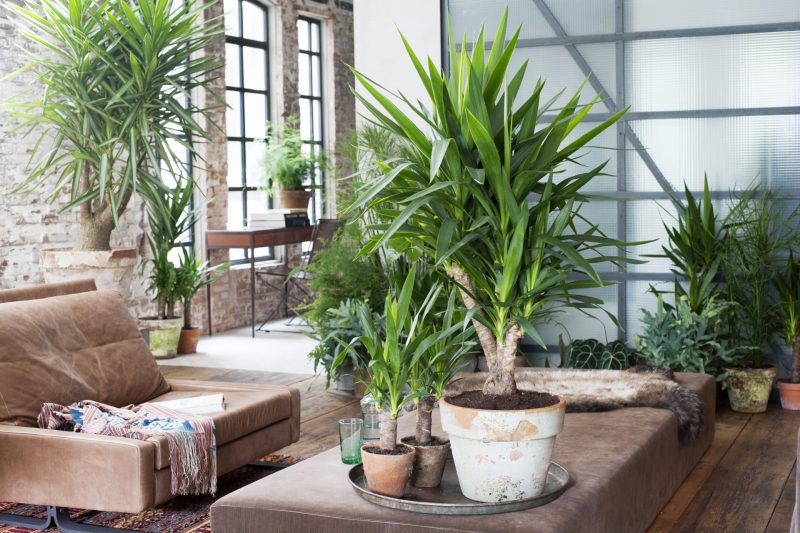
The most common among indoor growing are:
- The yucca is elephant. The birthplace of this species is South America. The name of the species was due to a kind of trunk in the form of an elephant's foot. During flowering, a panicle inflorescence with many white flowers appears in the plant. They can reach up to 7 cm in length.
- Yucca is filamentous. A plant that does not have a main stem can grow due to root shoots and offspring. Leaves of this species are pointed to the ends, reaching more than 50 cm in length. During the growing season produces a panicle with large inflorescences up to 10 cm. They have a white color with a yellow tint.
- Yucca Elefantis. Under natural conditions, it can reach more than 7 meters in height. In indoor conditions it grows slowly, capable of reaching growth of up to 2 meters. It has a thick trunk, at the top there are green leaves, lowered to the bottom.
Important! All varieties of room palm trees have distinctive features in appearance and color. But they require the same care at home.
Yucca - nuances of growing
Yucca belongs to the Agave family. More often it is called a palm tree, can be found as decoration of offices and large houses.
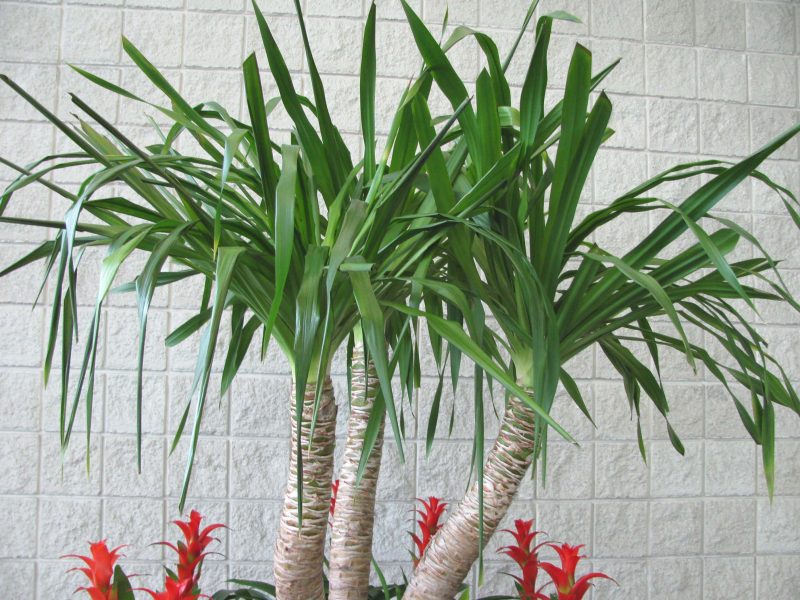
When cultivating it at home, there are certain nuances and requirements:
- Creation of favorable conditions close to a normal environment.
- Timely transplantation, soil preparation.
- Feeding, pest treatment.
- Reproduction.
To achieve a beautiful palm-shaped look, you need to trim the trunk. After time, shoots form on it. Over time, they will get stronger, and get a few trunks.
Important! Yucca palm requires free space, as it is large. It is an unpretentious evergreen plant. With sufficient and proper care, the owner will be pleased for a long time.
Home Care
As with many indoor plants, Yucca care should be fully implemented.
It consists of the following actions:
- optimal temperature and lighting;
- moderate humidity and excessive watering;
- fertile soil composition, drainage;
- fertilizing fertilizers;
- transplantation and methods of reproduction;
- timely control of diseases and pests.
In order to get a healthy indoor plant and achieve flowering, it is necessary to create conditions similar to natural ones.
Optimal conditions
Yucca room loves bright lighting. Due to a deficiency in the palm, leaves may be stretched, becoming dull. It is better to place the pot with the plant near the window on the south side so that most of the light falls on it. To do this, avoid direct sunlight, so as not to get burns on the leaves.

The optimum temperature in the hot season is 20-25 degrees. Every day, you can take the plant to fresh air for ventilation, avoiding strong winds and drafts. Do not allow the temperature to drop below 8 degrees, this can be fatal to the flower. In winter, it is better for a palm tree to organize additional lighting. The temperature during winter rest should not exceed 10-15 degrees.
Substrate requirements
An important point for planting or transplanting a room palm is the choice of substrate. You can buy ready-made in the store, intended for the agave family, substrate.
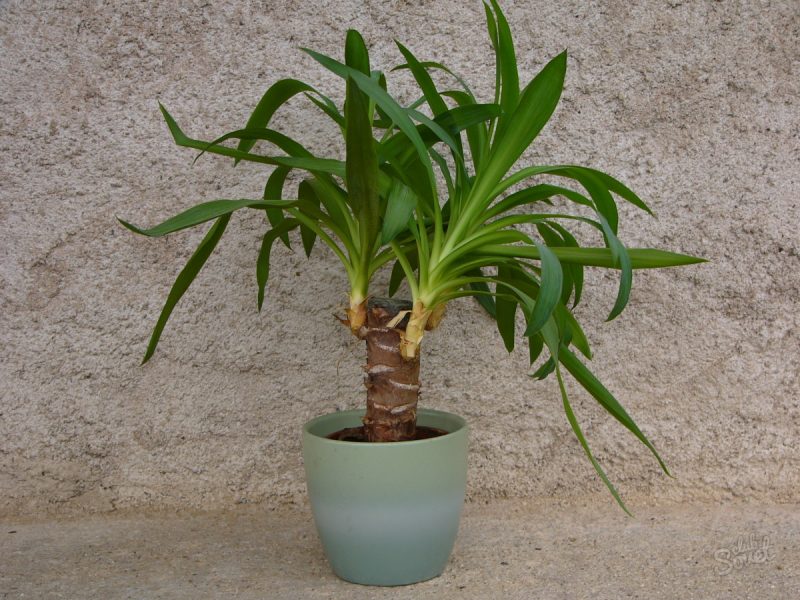
You can cook yourself by mixing from equal parts:
- turf land;
- sheet earth;
- humus;
- sand;
- peat.
Before the landing procedure, it is necessary to organize good drainage. It is allowed to lay a layer of expanded clay or large gravel on the bottom of the pot. The organization of drainage is a prerequisite for the full growth of the flower.
Irrigation system
Watering and irrigation directly depends on environmental conditions. At high temperatures and low humidity, watering a room tree is necessary every 2-3 days. Spraying is carried out daily, especially in the summer. The top layer of the earth will serve as a signal of watering. If it is dry, it is necessary to water the plant with settled water at room temperature.
In autumn and winter, watering should be reduced to 1 time per week. With an excess of moisture, twisted leaves appear on the palm tree, with the formation of spotting on them. When watering, it is important that the water does not fall on the leaf outlet, and also stagnates in the pot to prevent root decay.
Fertilizer and fertilizer
Top dressing must begin with the onset of early spring. For this, special mineral fertilizers are suitable. They are introduced with water during irrigation. It is necessary to do the procedure in the spring and summer period every 10 days. With the onset of autumn, top dressing should be reduced to 1 time per month. In winter, indoor yucca does not need fertilizers, it begins the time of winter rest.

Important! You can not make fertilizers for the indoor flower, the first two weeks after transplanting. It is necessary to wait until the plant gets stronger and its intensive growth begins.
How to care for leaves, dust removal
Unpretentious indoor flower is able to survive the arid climate. To maintain humidity, it is important to spray daily in the summer.In autumn, irrigation is done every other day. For the procedure, it is better to use clean, settled water at room temperature. Wipe the leaves regularly with a damp cloth, removing them from dirt and dust.

In the evening you can have a shower. To do this, put the pots on a pallet and water from a hose. Once a week, it is recommended to treat the leaves with soap and water, then rinse with clean water.
Propagation and transplantation of a flower Yucca
Yucca transplant is performed as the root system of the pot is filled. Or with rotting of the roots, or other diseases.
Transplantation consists of the following steps:
- Pick up a pot 2 cm larger than before.
- Prepare a fertile substrate, organize drainage.
- The plant is carefully taken out of the pot by the method of transshipment.
- Remove all rotten and damaged roots, old soil.
- Put the flower in the prepared container.
- Top up the soil, having slightly condensed it.
- Moisten the soil slightly, after which watering should be done after 2 weeks.
The need for a procedure every 2-3 years. It is better to do it in the spring. It is not allowed to transplant Yucca during winter dormancy.
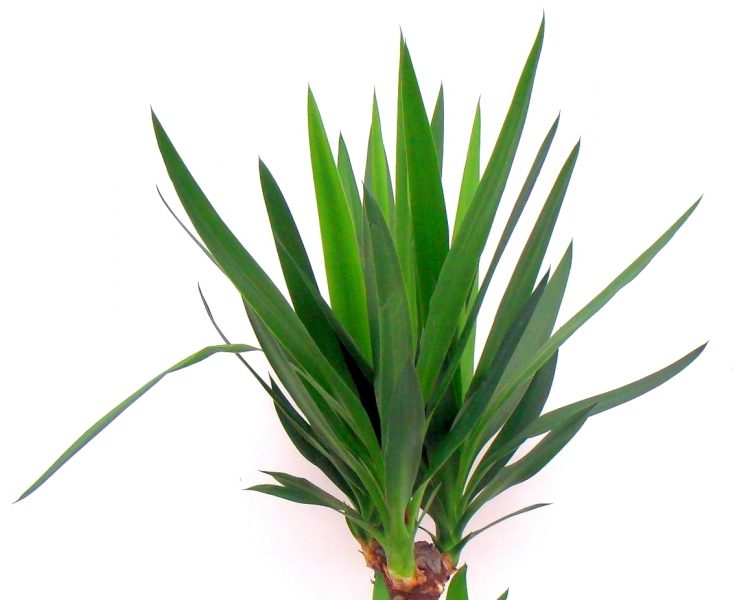
Like many plants, a palm tree can reproduce in several ways:
- by seeds;
- segments of the trunk;
- processes;
- apical stalk.
The seed method is best started in February. To do this, the seeds are sown in boxes prepared with soil, sprinkling a layer of the earth no more than 5 mm on top. Boxes are placed in a warm and bright place, covered with a film or glass top. Moisten with a spray gun so as not to wash the seed. Open the film daily for ventilation. After a month, the emergence of seedlings can be observed, the film must be removed.
In spring, the top of the leaves is cut off from the plant, and the place of cut is treated with garden var. After a certain time, new lateral shoots appear on the trunk. The top is put in a glass of water for 2 days. After it is placed in wet sand, covered with a film on top. After rooting, the top of the plant is planted in a separate pot prepared with soil.
To propagate the flower, the trunk is cut into several parts, the slice is treated with var. Parts of the trunk are planted in a prepared wet substrate of sand and peat, covered with a film on top, forming a mini greenhouse. After a month, remove the film. It is allowed to lay horizontally parts of the trunk, slightly pressing them to the soil. After a certain time, the kidneys will begin to appear on them. This method is best done in the summer, when the Yucca flower has intensive growth.
Diseases, pests and methods of dealing with them
Indoor plants can be subject to various diseases.
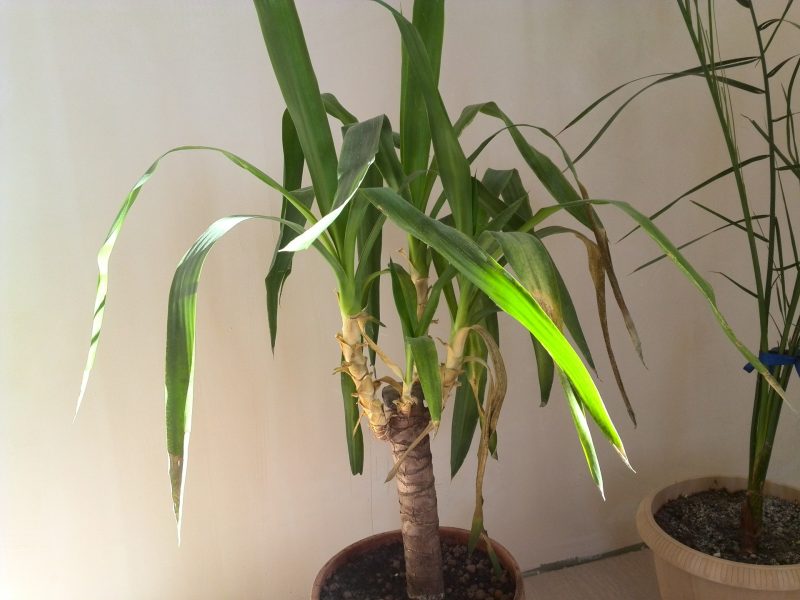
Yucca often, with improper care, can be exposed to fungal diseases:
- Spotting on the leaves. Fungal disease forms in the form of brown spots on the leaves. If you need to reduce watering, irrigation, reduce air humidity. All affected parts are removed from the plant.
- Rotting of the stem or roots. When identifying the first signs of the disease, it is important to remove from the main bush all the affected parts of the plant. Arrange moderate watering and reduce indoor humidity.
In addition to diseases, pests can appear on the flower. The most common and famous are: pseudoscutis and spider mite. A spider mite appears on the underside of the leaves. After which the leaves acquire a dull color and die off. In preventive measures, it is necessary to treat the leaves with a soapy solution, and spray the plant with insecticides. False shield affects not only the leaves, but also the stems. If you do not take pest control measures, the flower may die.
Possible growing problems
With improper and poor care of a houseplant, various problems can arise.
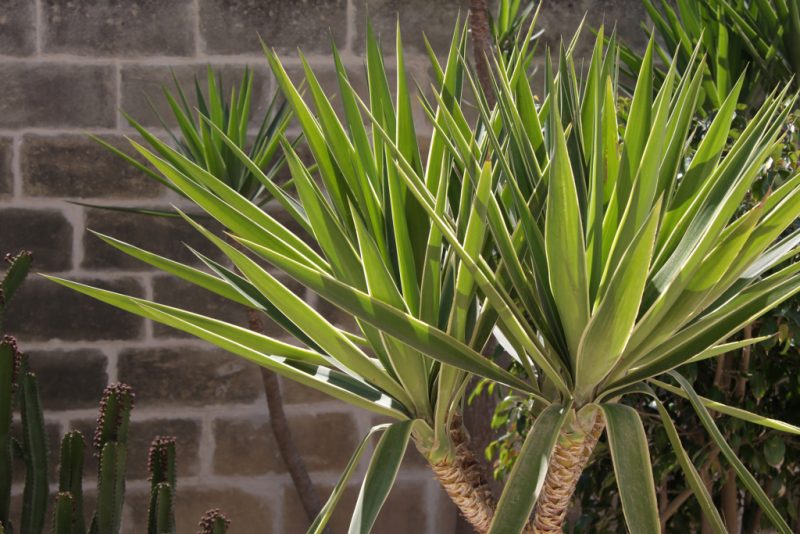
The most common mistakes when growing yucca in a room are:
- Due to waterlogging of the soil, dark spots appear on the leaves, and also the trunk becomes soft.It is necessary to reduce watering and reduce humidity in the room.
- Dry white spots on the leaves appear in a dry and highly lit room. It is necessary to change the place of the pot in partial shade.
- Foliage curls and brown spots appear due to lack of temperature and poor lighting during winter dormancy. It is necessary to provide the plant with additional lighting and increase the temperature.
- Fungal diseases appear due to an excess of moisture. Watering should be stopped, fertilizers should be applied in a timely manner.
- Rotting of the roots occurs if moisture accumulates in the pan. If detected, you need to transplant the flower, removing all the affected parts of the root system.
Yucca is an unpretentious plant, if you give it a minimum of time, it will perfectly decorate the interior.












